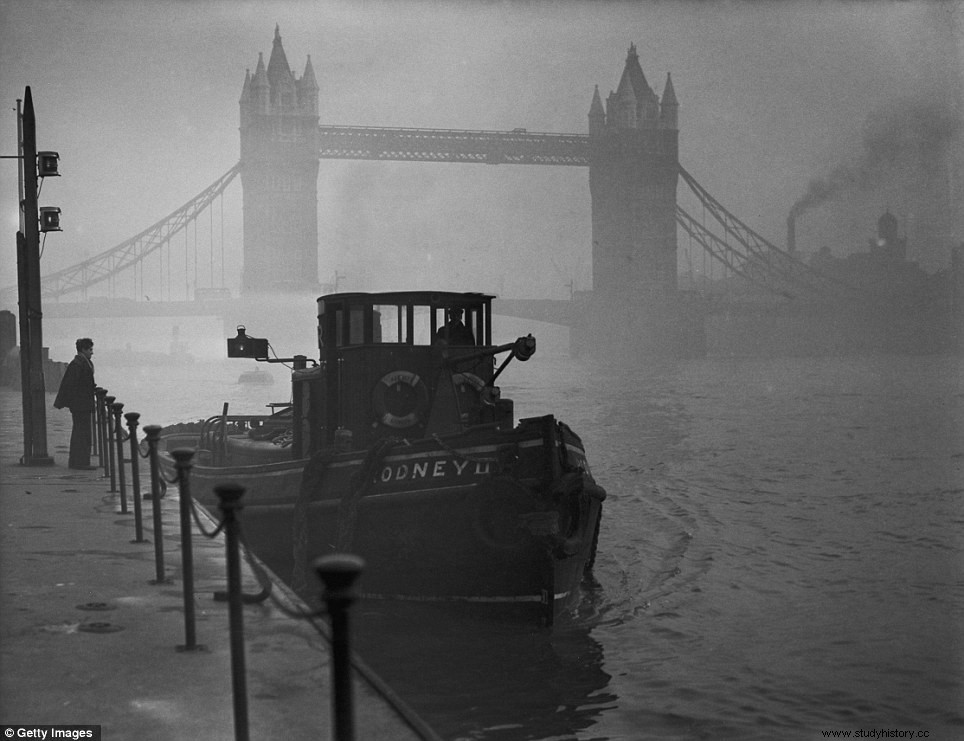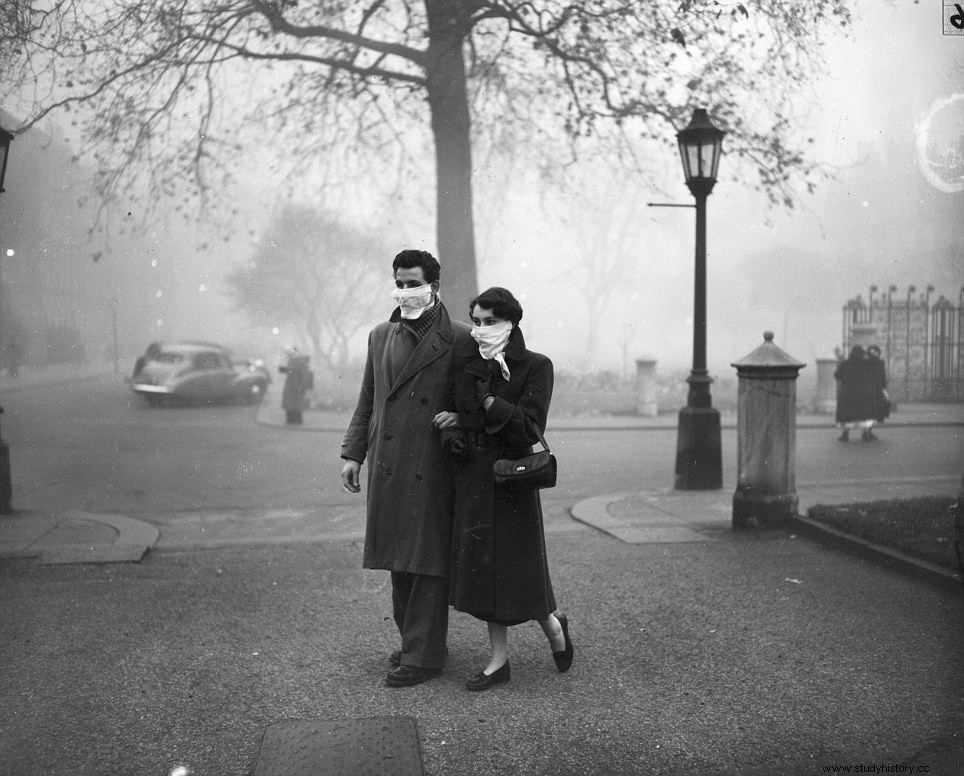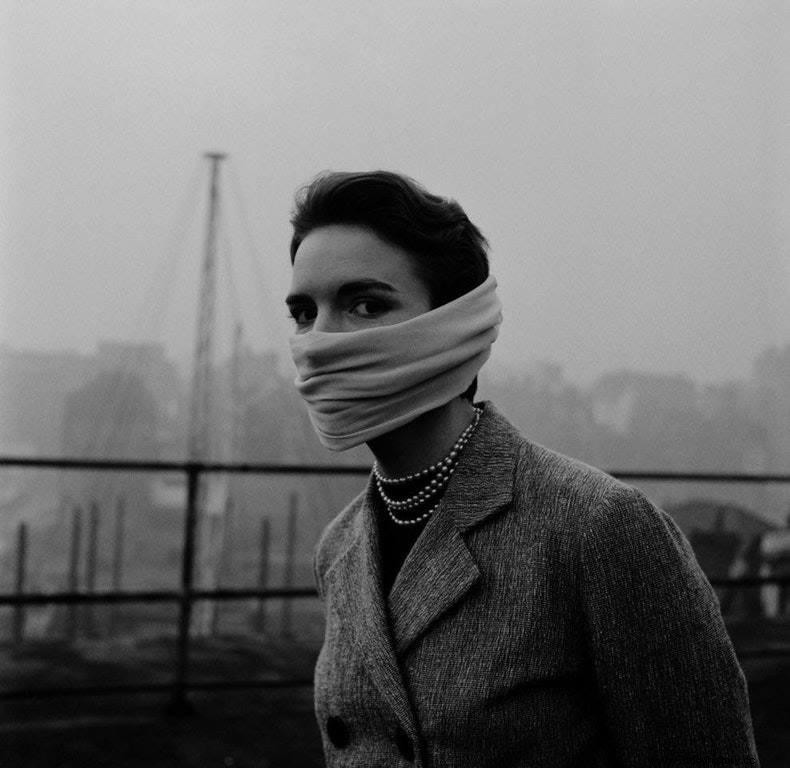“Fog everywhere. Fog upstream of the river, where it flows between green islets and meadows, fog downstream of the river where it unfolds among the alongside ships and the pollution of the shores of a noble (and dirty) city. The tirade stretched over several paragraphs to describe, in the novel The House of Harsh Wind, by Charles Dickens (1812–1870), the London of its day. He would not have denied a line of his story when he saw the Great Smog of London (The Great Smog or Fog Killer) of 1952.
A forgotten disaster, smog killed 12,000 people in four days in London.
A dense fog, green-yellow, choked the streets. The cars moved forward, the passengers sitting on the hood shouting instructions. From behind the wheel, drivers couldn't even see to their own headlights. Mothers took their children to school with handkerchiefs and scarves over their faces, hands tightly clasped. The post-war period was never so grim for the British who faced a mephitic pea puree on a daily basis. What is the origin?

A pedestrian remembers meeting a biker who asked him:“Where is the metro station?

A greasy, grimy fog rolled over the city, leaving a blanket of soot hanging over the streets so thick that visibility was reduced to a few feet or even less. The precedent that evokes living memory is linked to the Napoleonic era, 150 years earlier, when the city was paralyzed by swirling mists. When Dickens first started writing about these mists, he imagined dinosaurs coming out of the mist. Readers of Sherlock Holmes couldn't imagine the great detective without seeing him wandering down Baker Street, shrouded in strange tendrils of fog. The collective unconscious has therefore become accustomed to it.
But the Great Smog was not romantic. Outside the great pages of literature, he was a murderer. People and animals suffocated in appalling numbers, making it Britain's worst peacetime disaster of the 20th century. Drivers couldn't even see through their car's headlights.
To deal with it, Londoners had to call again on the spirit of the Blitz that had sustained them during the war.

Professor Roy Parker, now a social historian, lived with his parents in Lewisham, south-east London, in 1952. His father, a First World War veteran who had been gassed in the trenches, had the intended to cycle to work, even though the suffocating conditions caused severe pain in his bruised lungs. He was 56 years old and in great distress, out of breath, struggling. But he continued to cycle.
Buses could not run. A driver who tried to override it said "large flakes of soot stuck to the greasy windshield like paint" and couldn't be wiped away. To see a few feet ahead of him where his driver was walking with a torch to light the way, he had to lean out of the window.
In the East End, people couldn't see their own feet. Still, dockworkers reported that in crane cabins 50 feet off the ground, the sky was pretty clear. Below, the smog was like a black sea.

A band of high pressure then settled over London, holding the pollution in place, almost like a layer of oil on water. Conditions only worsened as homes stoked their fires. Domestic hearths were the biggest culprits:Households mostly burned the cheapest coal, which was heavy with dust. Before the advent of central heating, fire was the only way to heat rooms and was often used to boil water and even cook.
But the smog was also the result of a deadly climate cocktail produced by coal-fired factories, diesel fumes from trucks and buses, and clouds of pollution that drifted from continental industrial centers across the English Channel.
The scale of the pollution was incredible. Every day, 1,000 tonnes of smoke billowed from London chimneys, emitting 2,000 tonnes of carbon dioxide, 140 tonnes of hydrochloric acid and 14 tonnes of fluorine compounds. Even more deadly, 800 tons of sulfuric acid formed as sulfur dioxide from the smokestacks which mixed with the humidity in the air. The acid burned the back of the throat, causing fits of choking. It has, among other things, caused inflammation of the lungs, especially in children, the elderly and people with bronchial diseases. Thousands of people died, suffocated from within. As the death toll rose, the funeral directors ran out of coffins.

More than 100,000 people suffered from health problems such as bronchitis and pneumonia. According to some estimates, another 8,000 people died in the weeks and months that followed.
Sir Donald Acheson, the former Chief Medical Officer of the Government, recalls as a young doctor making his way through deserted streets:“I had to crawl along the walls of buildings, to the next corner, to read the name from the street. I remember an eerie silence, as there was little or no traffic. Visibility was less than three meters, and it was freezing cold”.
At Middlesex Hospital near Tottenham Court Road, where he was a resident doctor, Acheson saw an unbroken tide of admissions.
Within days, patients with acute respiratory distress were on every ward – they were in the surgery wards, and even in the obstetrics wards, and since the majority of them were men, he space had to be found in some of the women's rooms. The oxygen supply was pushed to the limit.
Commuters wore extra layers to protect them from dust and dirt on their way to work as London entered its second day of dense fog in 1952
Nothing could keep the smog out, and as it seeped inside, it left a black film on every surface. Even the cinemas were closed – the black pallor made it impossible to see the screens. At Sadler's Wells theatre, the opera La Traviata was interrupted due to the choking and coughing sound of smog pouring through the hall.
Dog racing in White City was discontinued because the greyhounds couldn't see…the hare.
Ambulances, of course, had to stay on the roads regardless of the conditions. A crew member drove the vehicle, while another walked in front, warning people to get out of the way.

Some trains were kept in service, but in near total darkness, ingenious measures were needed to avoid accidents.
Railway engineers placed small packets of explosives on the lines, which were detonated like pistol caps by the wheels as the trains moved down the tracks – the noise alerted the workers that a train was approaching. /P>
Richard Scorer, a professor at Imperial College, remembers cycling home in the fog, following the pavement at a snail's pace.
“I got very dirty,” he said during an inquest into The Great Smog, 50 years later. “My eyebrows were covered in what you might call mud, my hair was dirty and my hands had accumulated a lot of mud. It was as if I had fallen into a puddle of mud”.
And it wasn't just men, women and children. At the annual Smithfield Cattle Show at Earl's Court, the cattle gasped and collapsed. More than a dozen of them had to be shot to get them out of their suffering.
After five days, the weather changed. A breeze cleared the air, leaving an oily residue on every building and tree. It was as if the city had been sprayed with black. The rain came and washed the grime into the gutters, leaving a trickle of smelly soot.

Bus conductors were forced to walk in front of their buses, barely visible from a few meters away, to guide drivers through the streets of London with flaming torches during the smog
The government has been keen to downplay the scale of the disaster, and the health ministry released figures purporting to show the death toll was far lower than it actually was. In the Commons, Housing Minister Harold Macmillan, the future Conservative Prime Minister, attempted to blame the disaster on the weather and pointed to pollution as a necessary evil.
When the opposition benches criticized the government for not doing more to reduce pollution, he replied:"We are doing what we can, but of course the honorable member must realize the huge number of considerations general economic factors which must be taken into account and which it would be quite foolish to neglect”.
There was smog again, but never so much. A campaign by backbench MPs forced the Clean Air Act in 1956. It mandated the use of smokeless fuels in homes and ordered the relocation of power plants further away from cities. /P>
Never again will London see the return of a fog as choking, blinding and terrifying as the Great Smog that smothered the capital 60 years ago.

Source and references:
Britannica – Great Smog of London
History.com – the killer fog that blanketed london 60 years ago
Theverge – London great smog 1952:death in the air pollution book review john reginald-christie
Theguardian – 60 years great smog london in pictures
